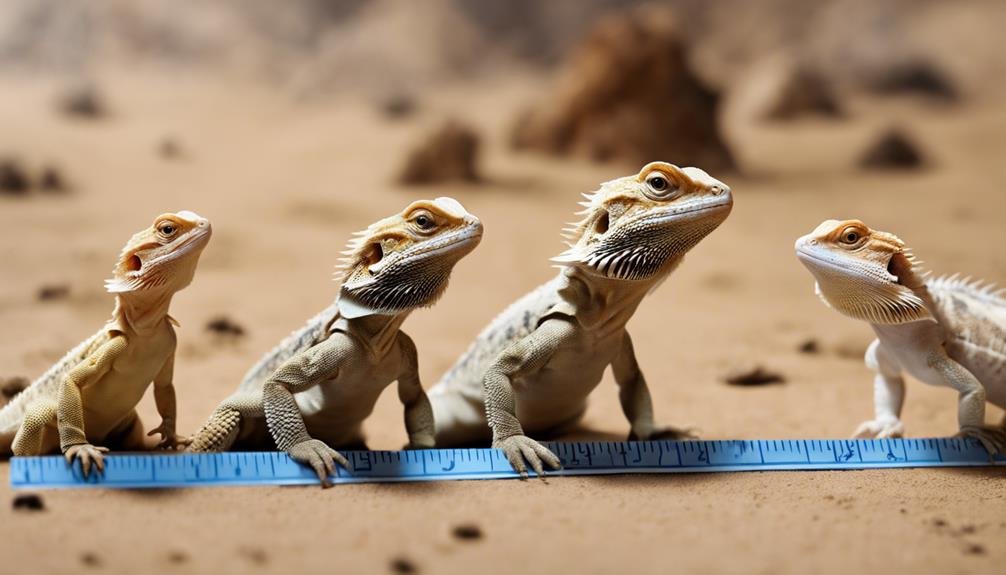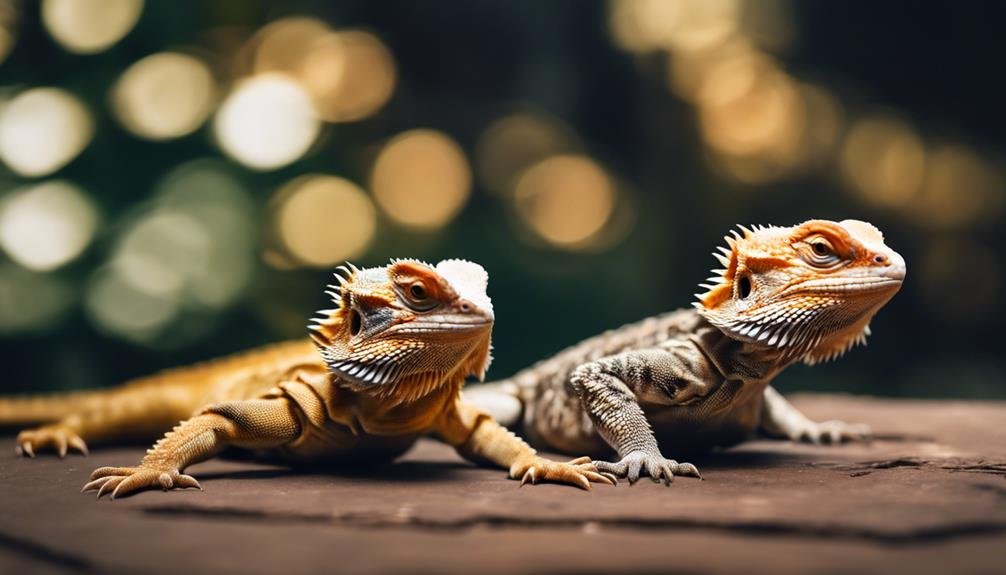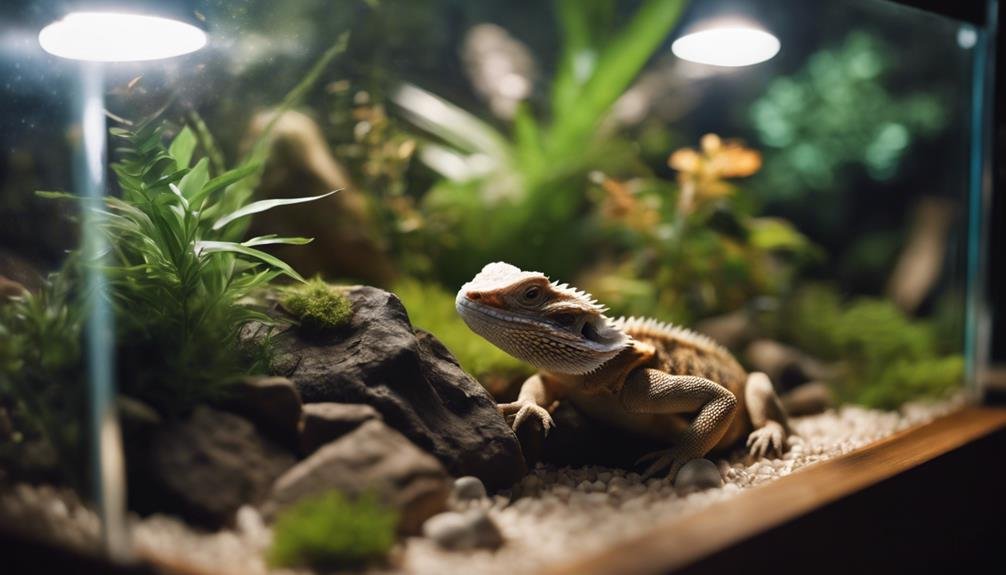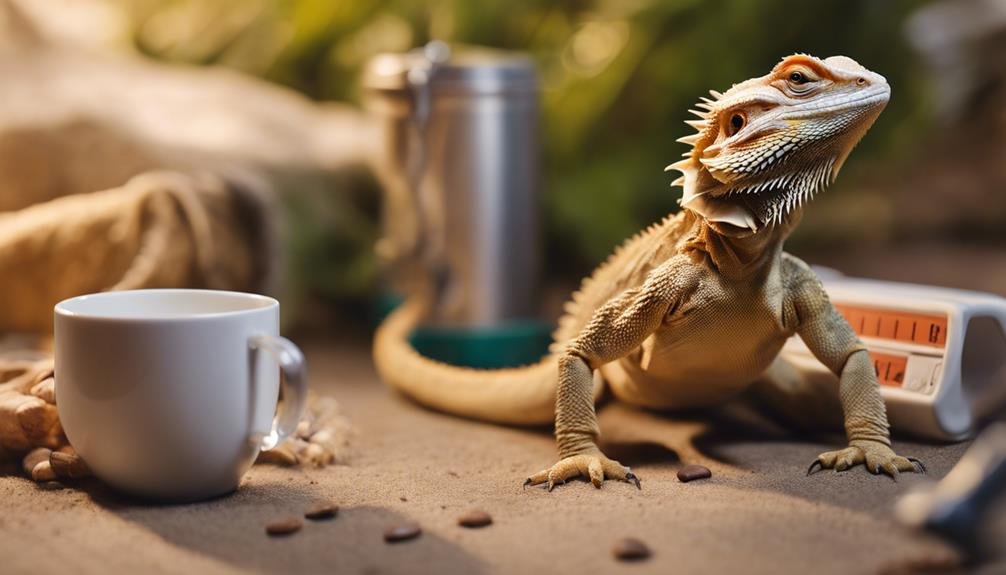Exploring the fascinating world of bearded dragons, you might wonder how large these reptiles can get. Typically, they reach lengths between 16 to 24 inches, but did you know that several factors can influence their growth? From their diet to the setup of their habitat, each element plays a critical role in how they develop. You’ll find that understanding these influences helps provide better care and anticipate how large your pet might become. Let’s start by examining what affects their growth and why closely monitoring these factors is crucial.
Key Takeaways
- Bearded dragons typically reach lengths of 16 to 24 inches as adults.
- Males are generally larger than females in size.
- Growth largely ceases around 12 to 18 months of age.
- Genetic factors can significantly influence the maximum size of bearded dragons.
- Captive bearded dragons often have more consistent growth rates due to controlled environments.
Bearded Dragon Growth Chart
To track your bearded dragon’s development, refer to the growth chart, which details its progression from hatchling to adulthood. Bearded dragons grow rapidly, evolving through various stages before reaching their full adult size.
Initially, hatchlings are about 3 inches long and weigh between 4 and 6 grams. As they enter the juvenile phase, they experience a significant growth spurt, eventually reaching up to 24 inches in length and weighing between 20 and 400 grams, depending on their gender and individual health.
Factors Influencing Growth
Understanding the factors influencing growth will help you guarantee your bearded dragon reaches its full potential. First off, diet plays an important role. A well-balanced diet rich in nutrients ensures your bearded dragon isn’t just surviving but thriving. You must provide a variety of foods to mimic their natural intake, including leafy greens and appropriate insects, supplemented with vitamins.
Lighting and temperature are equally significant. Proper UVB lighting mimics their natural environment and aids in calcium absorption. Without this, your dragon could face serious health issues. Speaking of calcium, supplementation is necessary. This mineral is essential for bone growth and overall health, helping prevent metabolic bone disease, a common illness in captive bearded dragons.
Lastly, please don’t overlook the impact of stress levels and the cleanliness of their environment. High stress can stunt growth and heighten illness risks. Keep their habitat clean and stress-free to promote a healthy, growing bearded dragon. By controlling these factors, you’re setting up your bearded dragon for a long, healthy life, allowing it to grow as large as genetically possible.
Average Size Milestones


Bearded dragons typically experience significant growth spurts, reaching lengths of 16-24 inches as adults, with males generally larger than females. Understanding the average size milestones will help you keep track of your pet’s healthy development. Initially, your bearded dragon starts at about 3 inches as a hatchling. The first few months are important; they can grow 1-3 inches per month, depending on their diet and health.
Monitoring their growth rates and weight is essential. If you’re monitoring properly, you’ll notice they reach different size milestones at various stages of their life. Here’s a quick guide to what you might expect:
| Age (Months) | Expected Size (Inches) |
|---|---|
| 1 | 4-6 |
| 3 | 8-12 |
| 6 | 12-16 |
| 12 | 16-20 |
| 18 | 18-24 |
Diet and Growth Correlation
Your bearded dragon’s growth heavily depends on a balanced diet of live insects and vegetables. This balanced diet is essential not only for their size but also for their overall health. Nutrition is the cornerstone of their development. You’re supporting your pet’s healthy growth by providing the right mix of nutrients, including essential vitamins and calcium.
A diet rich in live insects like crickets and mealworms is important, but it’s also crucial to moderate their intake. Overfeeding these protein-rich insects can lead to excessive growth and accompanying health issues, such as obesity or organ stress. Therefore, monitoring their weight gain and adjusting their diet is essential.
Incorporating vegetables and fruits adds necessary fiber and other nutrients to their diet, balancing out the high protein from the insects. This mix helps prevent rapid weight gain while ensuring they receive all the required nutrients. Remember, the goal isn’t just to grow your bearded dragon big and maintain their health through proper nutrition. A well-rounded diet enables excellent growth and a healthier, happier bearded dragon. So, keep a close eye on their dietary intake and adjust to foster their well-being.
Genetics and Size Variability


Genetics greatly influence how large your bearded dragon might grow, often setting the upper limits of their size regardless of other factors. If you’ve noticed some dragons in captivity reaching sizes slightly different from their wild counterparts, it’s often due to genetic variations. These genetics determine the potential maximum size and affect growth rates, which can vary greatly even among siblings.
Size variability is a fascinating aspect of bearded dragon care. You might find that despite providing an ideal environment, your dragon’s size could be largely dictated by its genetic makeup. These creatures face different survival challenges in the wild, which can also influence their growth. However, captive bearded dragons generally have more consistent growth rates due to controlled diets and stable living conditions.
It’s important to understand that genetics will play a key role while you can influence a bearded dragon’s growth through diet and habitat quality. Monitoring your dragon’s growth progression helps ensure it’s on track, but remember, each dragon is unique. So, genetics might be the answer if you’re wondering why your pet hasn’t reached the size of others you’ve seen.
Health Issues Affecting Size
While genetics set the stage for your bearded dragon’s potential size, various health issues can also greatly impact its growth. One significant health problem is metabolic bone disease, which can stunt its growth and affect its overall size. This condition often stems from an improper diet and a lack of calcium supplementation. Ensure your pet gets enough calcium to prevent this debilitating disease.
Moreover, obesity is another factor that can limit how large your bearded dragon can grow. This often results from overfeeding and a lack of exercise. You must diet carefully and do certain physical activities to maintain a healthy weight.
Additionally, high-stress levels can also play a detrimental role in your bearded dragon’s growth. Stress can weaken their immune system, increasing their susceptibility to illnesses like metabolic bone disease, further hindering their growth. Managing stress involves providing a stable and suitable environment alongside regular, gentle handling to acclimate them to human interaction. Addressing these health issues gives your bearded dragon the best chance to reach their full-size potential.
Proper Habitat Setup


Setting up the right habitat is essential for your bearded dragon to thrive and reach its full-size potential. Proper habitat setup starts with choosing the right vivarium. For an adult bearded dragon, you’ll need a space that’s at least 120cm x 60cm x 60cm. This size guarantees they’ve enough room to grow and move around comfortably.
Maintaining a correct temperature gradient within this vivarium is important. It would be best to have a hot end where temperatures range from 38-42°C and a cool end where temperatures are cooler, between 22-26°C. This gradient allows your bearded dragon to regulate its body temperature by moving between the zones.
Moreover, UV lighting is essential. Install a 10-12% fluorescent UV tube at the hot end of the vivarium. This setup prevents metabolic bone disease, a common health issue in bearded dragons when UV exposure is inadequate.
Lastly, the choice of substrate is crucial. It should be safe and easy to clean while also contributing to the overall environment of the vivarium. Add hiding spots, rocks, and branches to mimic their natural habitat and promote physical activity. These elements combined create a stimulating and healthy environment for your bearded dragon.
Monitoring and Measuring Growth
To effectively monitor your bearded dragon’s development, regularly measure their weight and length, noting any changes as they grow. Monitoring these aspects is crucial, especially during their first year when they experience rapid growth. You’ll see the most significant changes from 3 to 11 months as they approach their adult size.
Keeping track of their growth involves more than just observing their size increase; it’s about guaranteeing they’re developing healthily through proper nutrition and care. If you’re not seeing expected growth rates, it might indicate a need to adjust their diet or environmental conditions. This close attention helps you catch any potential health issues early.
Growth will slow as your bearded dragon ages, typically ceasing around 12 to 18 months. At this stage, measuring growth isn’t about looking for increases in size but ensuring they maintain a healthy weight and condition. Regular check-ins will help you ensure your bearded dragon isn’t just growing and thriving. Remember, each dragon is unique, and factors like genetics also play a significant role in their final size, so use these measurements as guides rather than absolutes.
Conclusion
As you’ve seen, your bearded dragon’s growth depends largely on diet, genetics, and habitat. By providing a balanced diet, appropriate UVB lighting, and a properly set enclosure, you can help guarantee that your pet reaches its full potential.
Monitor its growth milestones and consult a vet for health concerns. Remember, each dragon is unique so that yours might grow differently. Stay attentive and responsive to its needs for a healthy, happy dragon.
Related Article:
https://thereptileguide.com/corn-snake-care/
https://thereptileguide.com/bearded-dragon-morphs/


